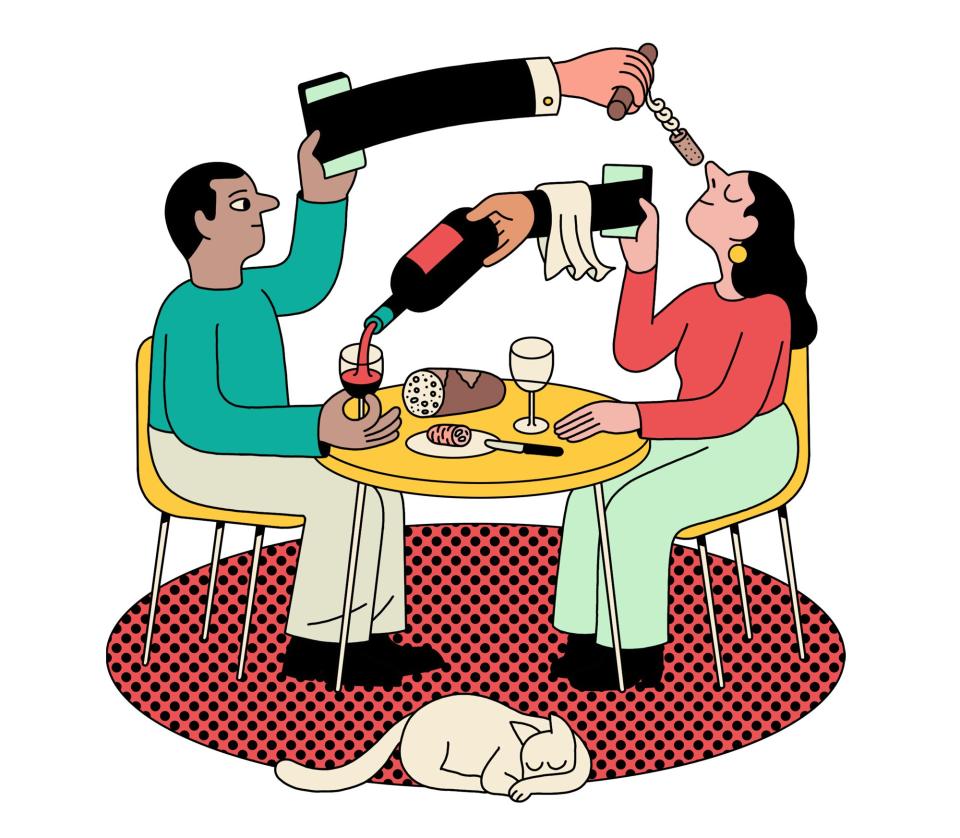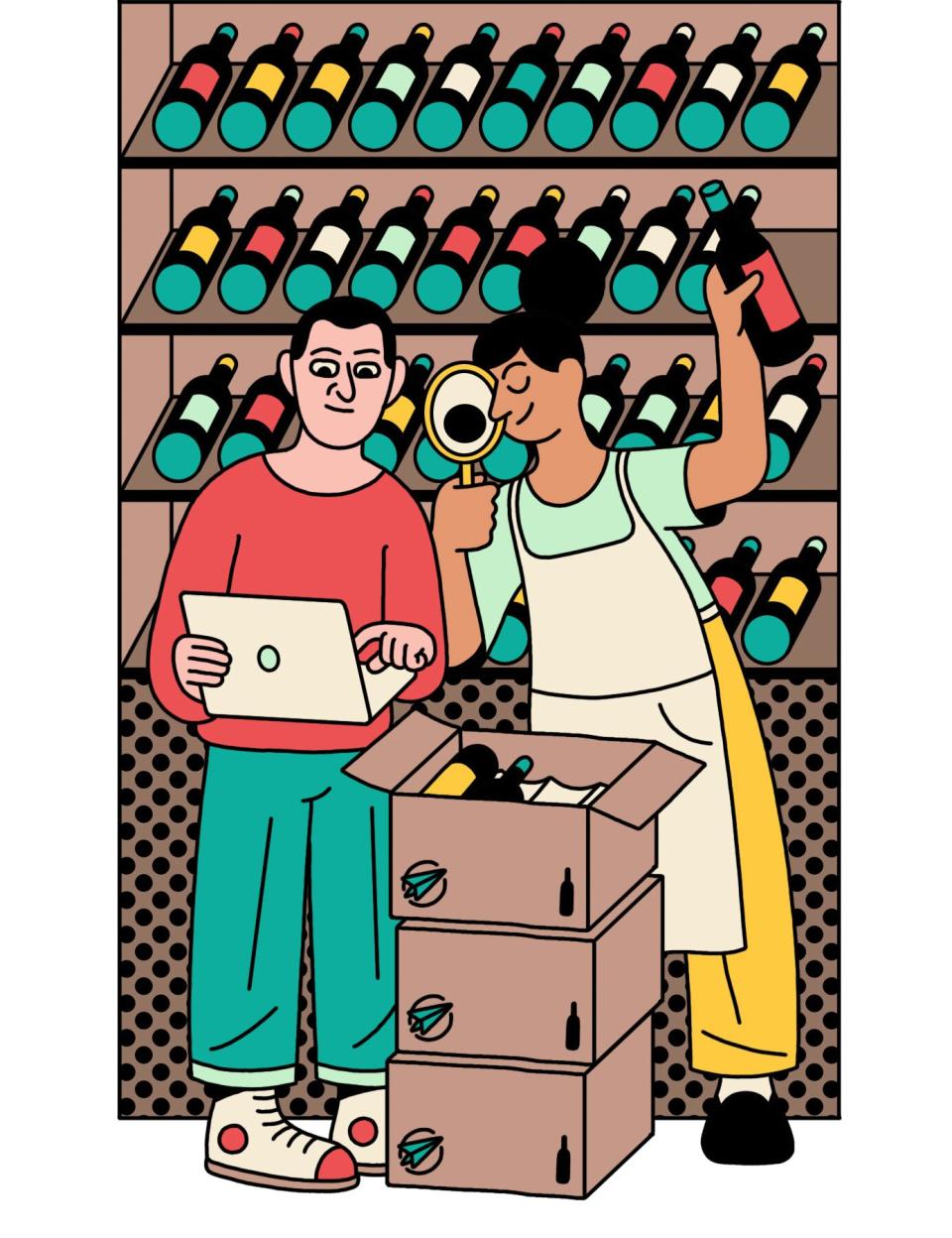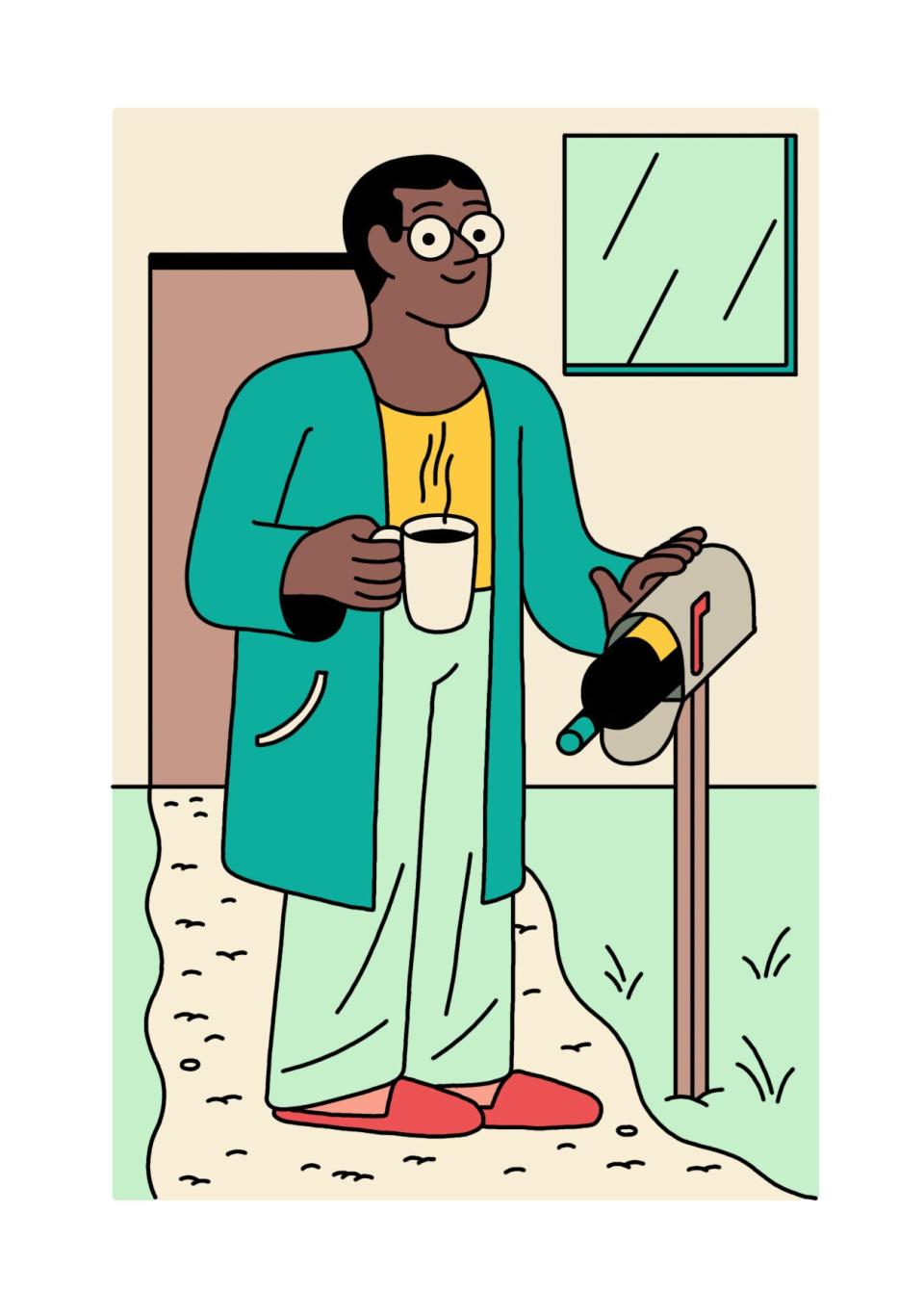The Way We Buy Wine Now
In the online I-want-it-now world, you can get almost anything you want any time you want. Push a button, fill out a form, and there at your door are dish towels and diamonds (4.1 carats, $75,960, yours on Amazon), cat food and caviar and chopsticks (why not LED light-saber ones, while you're at it?). I needed some touch-up paint for my car not long ago: It came to me second-day from Russia. Feeling bored and lonely? A virtual friend on replika.ai might help. Just feeling straight-up weird? Overnight yourself a Brazilian rainbow boa constrictor from xyzreptiles.com, and throw in some frozen mice for good measure. But surprisingly, when it comes to "almost anything," one of the few things that can actually be hard to get online is wine.

Illustration by Simon Landrein
Thanks to the United States' archaic state-by-state alcohol shipping laws, plus people's general uncertainty around choosing wine, online wine-buying has been a slow starter compared to every other thing that people buy. (I mean, come on: The idea that it's easier to get a seven-foot Amazonian reptile overnighted to you than a bottle of Cabernet, at least if you live in Alabama, as half of the Food & Wine staff does, is just really bizarre.)
READ MORE: 5 Great Virtual Wine Classes for All Levels
But the rise of millennials as wine-buyers has been gradually accelerating online wine-buying, and the pandemic added jet fuel to that trend. Consider wine.com, probably the premier online wine seller in the country, which saw 119% growth during 2020. "There were days during the lockdown where we had even 400% or 500% growth," Michael Osborn, wine.com's founder, says. Those numbers weren't sustainable, but they did add to a shift Osborn had been seeing for some time. "Home bread-making equipment, that's more a fad," Osborn says. "When people were stuck, they took up baking sourdough or making yogurt. But we've been up 15% yearly for the past five years in what's basically been a flat category."
Essentially, a side effect of 2020 was that many, many more people became aware that they could buy wine online -- through retailers like wine.com, via alcohol delivery companies like Minibar or Drizly (the latter just purchased by Uber for a whopping $1.1 billion, after seeing 350% growth last year), or directly from wineries themselves. As Gary Fisch of Gary's Wine & Marketplace, who operates stores in New Jersey and Napa Valley, notes, "During spring of last year, we went from 2,000 mobile app users to over 30,000 in two weeks." After discovering the convenience of apps like Gary's, most people have stuck with them. Osborn says, "Our mobile app is frequently half our business. And millennials -- who made up 44% of our new customers in 2020 -- are much more likely to use their app to make a purchase."
Throw in the boom in video tastings online, a proliferation of online wine courses, an explosion of narrowly focused wine clubs, and the realization that for many small wineries, selling directly to customers is the only way to make a profit in a business ever more dominated by big commercial brands and wholesalers, and it's clear we're on the cusp of an entirely new wine-buying landscape. But what will that mean?
When I first got into wine myself, I always found that poking around in a wine shop reminded me of browsing in a bookstore. Sure, I wanted to buy something to drink later, but part of the pleasure was lingering over all those bottles, all those possibilities: this shelf of Châteauneufs here, those Chiantis over there, that intriguing locked cabinet of rarities (miles beyond my budget) over by the cash register. Maybe I felt that way because, like books, great wines also tell stories. Admittedly, I'm both a wine geek and a book lover, but I wonder if my interest would have been kindled the same way if I'd only ever bought wine online. Hard to say. I hope so. But no matter what, it's something that anyone growing up now will find out.
The New Wine Clubs
Super-focused and super-interesting.

Illustration by Simon Landrein
It used to be that there were two kinds of wine clubs. The first you joined on that trip you took to Napa, when you fell in love with a specific winery. The second you joined because someone hit you with an ad saying "12 wines for only $85!!" and it seemed (at the time, though now you're starting to wonder ...) like a good idea.
The truth is that winery-specific clubs are great if you really love the wine from that one producer. The other large-scale clubs are mostly bulk wine branded with made-up names -- that "Château Bec de Canard" you bought for $4 in the initial offer is really "Château We Have a 50,000-Gallon Tank of Juice to Get Rid Of" that some marketer slapped a fanciful name on.
But the new world of wine clubs is more focused and honestly more exciting. Love natural wines? Want to dive deep into a specific region? Keen to have the best wine bar in Rome curate a selection for you? It's all possible. Here are some of my favorites.
Roscioli Italian Wine Club
Rimessa Roscioli -- a top wine destination in the heart of Rome -- now has a club that U.S. wine lovers can join. Excellent, hard-to-find selections, like a delicate Langhe Nebbiolo from boutique producer Scarzello, together with access to winemaker videos and an online wine community, set this club apart. $213 for six bottles, shipping included, roscioliwineclub.com
Orange Glou
Orange wines (or skin-contact white wines) have become more and more popular in recent years but can be tough to find at your local store. New York–based sommelier Doreen Winkler decided to solve this problem with her Orange Glou wine club. She says, "I'm able to snatch up sought-after orange wines and mix them up with great new producers I've just discovered." $105 for three bottles monthly, orangeglou.com
Flight Cru
Sommelier and wine educator Cha McCoy's travel-themed wine club provides more than just wine. A recent Tuscan offering included the gorgeous 2019 Costa Toscana Bianco di Ampeleia, discounts on McCoy's guided online tastings, and restaurant and winery recommendations; a south of France flight had a virtual cooking demo from a Marseille local. $208 for six bottles, chamccoy.com
Wines of the Santa Cruz Mountains
The Santa Cruz Mountains region produces superb Pinots, Chardonnays, and Cabernets, but its small-production wines can be hard to find in stores. The region's new club offers shipments three times per yearwith wines from star producerssuch as Rhys, Ridge, and Thomas Fogarty, plus privatevirtual tastings. $140–$200 for four bottles, winesofthesantacruzmountains.com
MYSA Natural Wine Club
MYSA's well-chosen bottles offer a great introduction to the world of natural wine: small producers, minimal intervention, biodynamic or organic farming, little to no sulfites. The club also donates 1% of its sales to offset the environmental impact of shipping wines. Guided video tastings led by founder and sommelier Holly Berrigan give insight, as well. $85 for three bottles, mysa.wine
From the Barrel to You
For boutique wines, go direct.

Illustration by Simon Landrein
Supermarket wine shelves are devoted to big-name brands, the Barefoots and Apothics of the world. Independent wine stores offer more curated selections, but what about that minuscule-production Syrah you've read about but can never seem to find anywhere? Odds are, it's available almost exclusively direct from the winery.
The truth is that the wine-sales playing field is skewed against small producers. As Jamie Kutch, who makes spectacular single-vineyard Pinots in Sonoma County, says, "Trying to compete with bigger brands, and the incentives they give to wholesalers, is just impossible. None of us -- the little artisan boutiques -- would be here if we didn't sell wine direct."
The good thing is that wine-shipping laws have loosened over time, and these days only six states completely prohibit shipments from out-of-state wineries (Utah, Arkansas, Mississippi, Alabama, Delaware, and Rhode Island; check out freethegrapes.org). Consider the excellent wineries to the right, recognize that there are hundreds more like them to discover, and know that the easiest -- and often the only -- way to get their wines is to go directly to the winery website.
Kutch
2018 Sonoma Coast Pinot Noir ($39)
Jamie Kutch has a gift for great Pinot Noir. Most of his wines are single-vineyard efforts, but this regional bottling is a great introduction to his talents. It's beautifully poised, with toasty, dark-berry flavors that end with a spicy edge. kutchwines.com
Newfound Wines
2018 Yount Mill Vineyard Grenache ($45)
Matt Naumann serves as the president for Dwyane Wade's Napa wine label, Wade Cellars, but to get Naumann's own wines, you have to go straight to the source. From a single acre of vines, this is Grenache at its silky, expressive best, crisp and bright with juicy red raspberry fruit. newfoundwines.com
Kings Carey
2018 San Luis Obispo Syrah ($34)
James Sparks' day job is making extremely good Chardonnay for Liquid Farm in the Santa Ynez Valley (also easiest to find direct at liquidfarm.com). His other job is his own super-tiny Kings Carey label. This bottle is California Syrah that hearkens back to the northern Rhône, all cured meat, white pepper, and red plum flavors. kingscarey.com
Relic Wine Cellars
2018 The Archive Sonoma Coast Pinot Noir ($30)
Relic's top wines are brilliant but can be pricey -- its powerful Artefact Cabernet runs $125 a bottle. On the other hand, winemaker Michael Hirby's more affordable Archive range offers remarkable quality at less wallet-squeezing prices. This floral Pinot, full of mouth-coating red cherry flavor, is impossible to resist. relicwines.com
Limerick Lane
2018 KATZ Vineyard Zinfandel ($62)
While it's true that Limerick Lane's basic Russian River Zinfandel can be found in stores, Jake Bilbro's many single-vineyard, old-vine Zinfandels are produced in tiny amounts. They are perennially superb -- this peppery, fragrant wine from the 109-year-old Katz vineyard is a fine example -- but to get them, definitely go direct. limericklanewines.com

